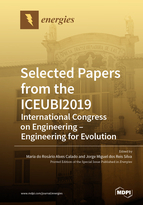Selected Papers from the ICEUBI2019 – International Congress on Engineering – Engineering for Evolution
A special issue of Energies (ISSN 1996-1073). This special issue belongs to the section "G: Energy and Buildings".
Deadline for manuscript submissions: closed (30 June 2020) | Viewed by 18351
Special Issue Editors
Interests: power systems optimization and control; energy conversion systems; renewable energy and energy harvesting; industrial automation; electric road vehicles
Special Issues, Collections and Topics in MDPI journals
Interests: transportation (in general) and air transport in particular (including operations research); flight safety and security
Special Issues, Collections and Topics in MDPI journals
Special Issue Information
Dear Colleagues,
ICEUBI is an International Congress on Engineering organized every two years by the Faculty of Engineering of the University of Beira Interior, Portugal, and aims to promoteengineering in society, ensuring contact between researchers and practitioners from different fields of engineering and permitting the dissemination of engineering research, innovation, and development within various sectors of economic activity.
The 2019 event aims to promote the contribution of Engineering for Evolution, and comes on the heels of the successful ICEUBI 2011, 2013, and 2015, where a significant number of scientific communications were submitted by participants from different countries (ICEUBI is considered as a reference organization in the field of engineering).
The scope of ICEUBI 2019 includes all matters within the scope of engineering and will provide a place for academics, research-focused practitioners, and policy makers to present research findings in the areas of engineering and other related areas.Submissions on aeronautics and astronautics, architecture and construction, informatics, textile science and technology, civil engineering, electrotechnical engineering, mechanical engineering, bioengineering and industrial engineering and management, related to the topics of energy ((1) fundamentals, (2) sources, (3) exploration, (4) conversion, and (5) policy), are welcomed.
Prof. Dr. Maria do Rosário Alves Calado
Prof. Dr. Jorge Miguel dos Reis Silva
Guest Editors
Manuscript Submission Information
Manuscripts should be submitted online at www.mdpi.com by registering and logging in to this website. Once you are registered, click here to go to the submission form. Manuscripts can be submitted until the deadline. All submissions that pass pre-check are peer-reviewed. Accepted papers will be published continuously in the journal (as soon as accepted) and will be listed together on the special issue website. Research articles, review articles as well as short communications are invited. For planned papers, a title and short abstract (about 100 words) can be sent to the Editorial Office for announcement on this website.
Submitted manuscripts should not have been published previously, nor be under consideration for publication elsewhere (except conference proceedings papers). All manuscripts are thoroughly refereed through a single-blind peer-review process. A guide for authors and other relevant information for submission of manuscripts is available on the Instructions for Authors page. Energies is an international peer-reviewed open access semimonthly journal published by MDPI.
Please visit the Instructions for Authors page before submitting a manuscript. The Article Processing Charge (APC) for publication in this open access journal is 2600 CHF (Swiss Francs). Submitted papers should be well formatted and use good English. Authors may use MDPI's English editing service prior to publication or during author revisions.
Keywords
- Aeronautical and aerospace energy systems
- Energy and buildings
- Renewable energy sources
- Fossil energy sources
- Domestic and industrial applications
- Energy saving and efficiency
- Energy conversion and management
- Bioenergetics
- Chemical energetics
- Sustainable energy systems
- Energetic materials
- Energy conversion systems
- Energy policy






